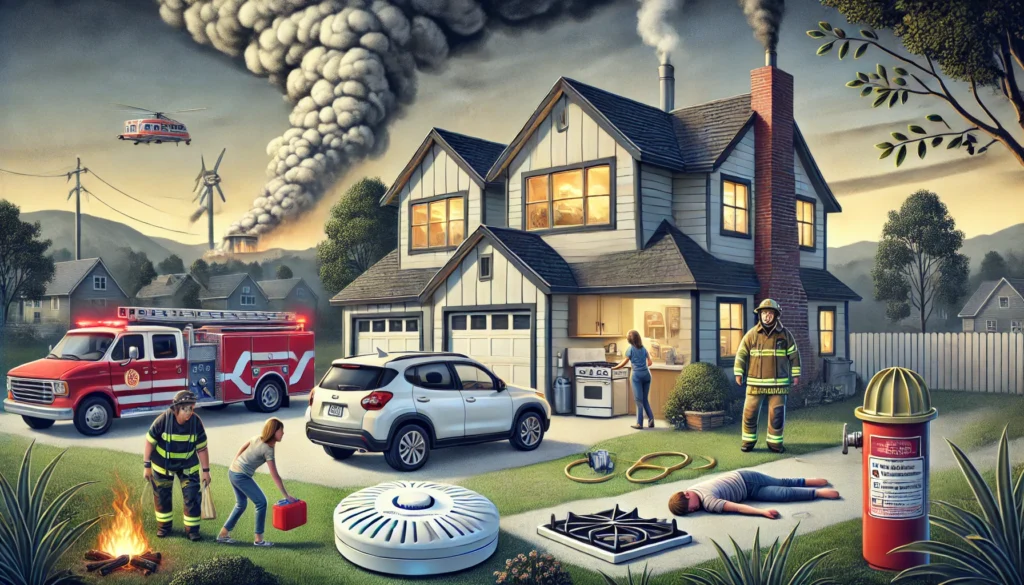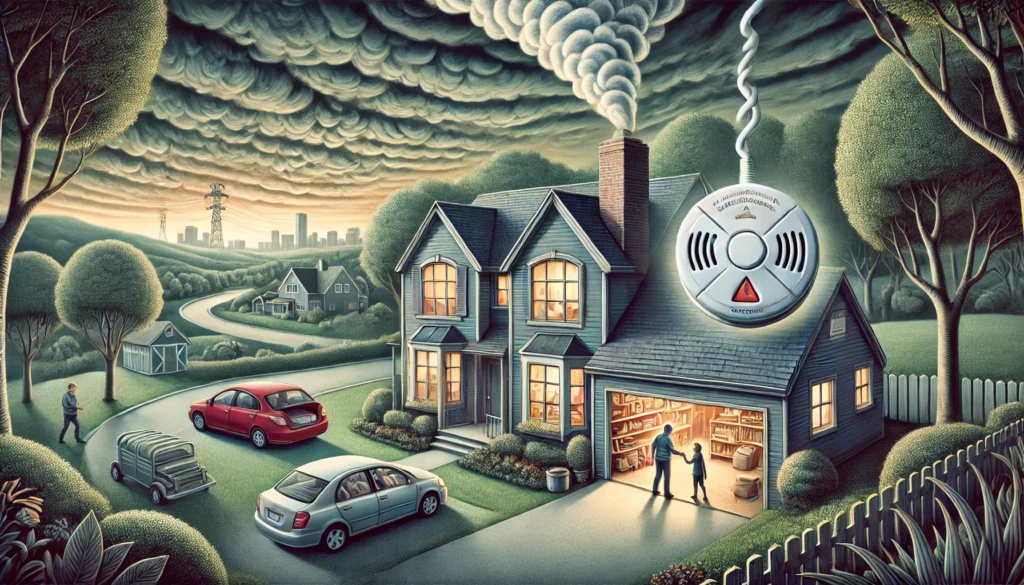Carbon monoxide (CO) is a deadly gas that lurks unnoticed in homes, vehicles, and other enclosed spaces. Known as the “silent killer,” this poisonous, odorless, and colorless gas claims lives and sends thousands to hospitals every year. Because it’s impossible to detect with human senses, understanding how to detect carbon monoxide is critical to protecting yourself, your family, and even your pets. In this detailed guide, we’ll explore everything you need to know about detecting carbon monoxide, including its nature, sources, detection methods, symptoms of poisoning, preventative measures, technological advancements, and the real-world impact of this invisible threat.
Table of Contents
What Is Carbon Monoxide?
Carbon monoxide is a gaseous byproduct of incomplete combustion, produced when fuels like gas, oil, coal, or wood don’t burn fully. According to the National Institute of Standards and Technology (NIST), this occurs when there’s insufficient oxygen for complete combustion, leaving CO as a dangerous residue. Its lack of color, odor, or taste makes it undetectable without specialized tools, which is why it’s so hazardous.
Exposure to CO can lead to severe health consequences—or even death—by binding to hemoglobin in the blood, reducing the oxygen supply to vital organs. Mild exposure might feel like the flu, while high concentrations can kill within minutes. This makes knowing how to detect carbon monoxide an essential skill for every household.
Sources of Carbon Monoxide: Where It Hides

To master how to detect carbon monoxide, you first need to know where it comes from. CO can originate from a surprising variety of sources, many of which are common in everyday life. Here’s a comprehensive breakdown:
1. Faulty or Poorly Maintained Fuel-Burning Appliances
- Heating Systems and Water Heaters: Poorly functioning furnaces, gas boilers, or water heaters can release CO if not serviced regularly.
- Gas Appliances: Gas stoves, ovens, and even cloth dryers can emit CO when ventilation is inadequate or burners are misadjusted.
- Wood-Burning Stoves and Fireplaces: Blocked chimneys or improper burning can cause CO buildup.
- Kerosene Heaters, Charcoal Grills, and Camping Stoves: Using these indoors is a major risk. For example, burning charcoal inside is explicitly warned against due to its high CO output.
2. Motor Vehicles and Engines
- Cars in Garages: Running a vehicle in an attached garage—even with the door partially open—can allow CO to seep into your home. Always ensure the garage door is fully open before starting the engine.
- Portable Generators: These devices produce more CO than car exhausts and must never be used indoors or near windows, doors, or vents (at least 20 feet away is recommended).
- Motorboat Exhaust: Open-air exposure to boat engine exhaust can also pose a CO risk.
3. Unusual and Overlooked Sources
- Underground Electrical Cable Fires: These can release CO that infiltrates nearby homes.
- Hookah Smoking: Indoor use of hookahs can produce small but harmful amounts of CO.
- Paint Removers with Methylene Chloride: This chemical converts to CO in the body and should only be used outdoors.
Identifying these sources is the foundation of detecting carbon monoxide before it becomes a problem.
How to Detect Carbon Monoxide: Tools and Techniques
Since CO is imperceptible to human senses, specialized tools and awareness are your best defenses. Here’s how to detect carbon monoxide effectively:
1. Carbon Monoxide Detectors: The Gold Standard
CO detectors are the most reliable way to detect carbon monoxide. These devices measure CO levels in parts per million (ppm) and sound an alarm when concentrations become dangerous over time. Here’s how to use them:
- Placement: Install detectors on every floor of your home, including the basement, and near sleeping areas for maximum protection. Position them close to potential CO sources like furnaces, fireplaces, and water heaters, but avoid placing them in kitchens or bathrooms where false alarms might occur.
- Maintenance: Test detectors monthly using the test button, replace batteries every six months (a handy tip is to sync this with daylight saving time changes), and replace the entire unit every 5-7 years, as sensors degrade over time.
- Types of Sensors: CO detectors use electrochemical sensors, metal oxide sensors, or biomimetic sensors that mimic hemoglobin’s reaction to CO, ensuring accurate detection.
Key Difference: CO detectors are distinct from smoke detectors. Smoke detectors sense particles in the air, while CO detectors are engineered to detect carbon monoxide gas. For full safety, install both types—or opt for combination detectors that cover both threats.
2. Physical Signs of a CO Leak
While not a substitute for detectors, certain visual and physical clues can hint at a CO problem:
- Black, Sooty Marks: Look for these on gas fire covers or around appliances.
- Sooty or Yellow/Brown Stains: These may appear on boilers, stoves, or fireplaces.
- Heavy Condensation: Excessive moisture on windows near fuel-burning appliances can signal poor combustion.
- Smoke Buildup: This can occur in rooms with fireplaces if chimneys lack an upward draft.
- Yellow or Orange Flames: Gas appliances (except natural gas fireplaces) should burn with a blue flame; yellow or orange flames indicate incomplete combustion.
- Pilot Lights Issues: Frequent blowouts or a blue flame burning improperly suggest a problem.
- Slow-Burning Fires: Solid fuel fires that burn slower than usual may be releasing CO.
- Unusual Humidity or Stale Air: These less common signs might accompany a CO leak.
If you spot these, check your CO detector and call a professional to inspect your appliances.
3. Related Odors
While CO itself is odorless, associated smells might alert you:
- Rotten Eggs: This indicates a natural gas leak, which can coincide with CO.
- Exhaust Fumes: High CO levels in vehicle or generator exhaust might be noticeable.
- Overheating or Burning: A stale room or burning smell could suggest a related issue.
Any unusual odor warrants immediate action—check your detector and ventilate the space.
4. Symptoms as a Detection Clue
Recognizing symptoms of CO poisoning is another way to detect carbon monoxide. These vary by exposure level:
- Mild Exposure: Headache, shortness of breath, dizziness, confusion, chest tightness, weakness, nausea, vomiting, or stomach pain. These mimic flu symptoms (without a fever), making them easy to misdiagnose.
- Severe Exposure: Drowsiness, fainting, clumsiness, difficulty walking, impaired vision, seizures, or coma. Death can occur rapidly at high levels.
- Tell-Tale Signs: Symptoms that improve outdoors and return indoors, or multiple occupants (including pets) feeling unwell simultaneously, strongly suggest CO.
The COMA acronym is a handy tool:
- Cohabitants/co-occupants affected
- Outdoors improves symptoms
- Maintenance of appliances is poor
- Alarm is absent or not functioning
Pets may show lethargy or odd behavior, acting as early warnings.
Symptoms of Carbon Monoxide Poisoning: Know the Signs

CO poisoning symptoms depend on exposure duration and concentration, as well as individual health. Here’s a detailed list:
Mild Symptoms
- Headache
- Shortness of breath or rapid breathing
- Dizziness or confusion
- Chest pain or tightness
- Weakness or fatigue
- Nausea, vomiting, or stomach pain
These often resemble the flu (minus a fever), which can delay recognition.
Severe Symptoms
- Drowsiness or fainting
- Clumsiness or difficulty walking
- Impaired vision
- Seizures or fits
- Coma or death (in extreme cases)
Additional Indicators
- Symptoms easing when you leave the building and worsening upon return.
- Multiple people or pets affected at once.
If you suspect CO poisoning, evacuate to fresh air immediately, ensuring your safety first, and seek emergency medical help or call the national Poison Help hotline. Even mild symptoms—or suspected exposure without symptoms—require a doctor’s visit. Pets should also be removed and checked.
Preventing Carbon Monoxide Leaks: Proactive Steps
Prevention is as vital as knowing how to detect carbon monoxide. Here’s how to keep CO at bay:
1. Install and Maintain CO Detectors
- Place detectors near bedrooms and test them regularly.
- Replace batteries biannually and units every 5-7 years.
2. Service Appliances Annually
- Hire a qualified technician to inspect heating systems, water heaters, and other fuel-burning appliances yearly.
3. Ensure Proper Ventilation
- Ventilate all fuel-burning equipment adequately.
- Check chimneys annually for blockages or poor draft.
4. Use Appliances Safely
- Never use gas ranges, ovens, or dryers for heating.
- Avoid indoor use of portable heaters, camp stoves, or charcoal grills.
5. Vehicle Safety
- Open the garage door fully before starting a car.
- Keep gasoline-powered engines at least 20 feet from windows, doors, or vents.
6. Other Precautions
- Avoid indoor smoking, especially hookahs.
- Use only gas equipment certified by a national testing agency.
- Never seal vent pipes with temporary fixes like tape.
These steps reduce the risk of CO buildup significantly.
Technological Advancements: The Future of CO Detection
Innovations are enhancing our ability to detect carbon monoxide:
1. Smart CO Detectors
These integrate with home security systems, sending alerts to your phone when CO is detected, even remotely.
2. Automated Ventilation Systems
Students in Kashmir patented a device that detects CO in enclosed spaces, automatically opens a window when levels rise, and closes it when safe. It’s been tested in hospitals, showing real-world promise.
3. Car CO Detectors
An Arduino student project aims to build CO detectors for vehicles that alert occupants, roll down windows, and send distress signals, adding a new layer of safety.
These advancements complement traditional detectors, offering smarter, more responsive protection.
The Real Impact of Carbon Monoxide
CO is a serious public health issue. In the U.S., it kills about 400 people annually and hospitalizes tens of thousands. While awareness and detection have reduced cases to fewer than 1,000 poisoning incidents yearly, the danger persists. In regions like Jammu and Kashmir, winter reliance on gas and coal heaters heightens the risk, underscoring the global need for vigilance.
What to Do If You Suspect a CO Leak
If you think CO is present:
- Evacuate: Move everyone (including pets) to fresh air immediately.
- Get Help: Call emergency services or the Poison Help hotline.
- Stay Out: Don’t re-enter until a professional confirms it’s safe.
Prompt action can be lifesaving.
Conclusion: Knowledge Is Your Best Defense
Understanding how to detect carbon monoxide is your strongest weapon against this silent killer. By installing CO detectors, recognizing sources and symptoms, and adopting preventative measures, you can safeguard your home and loved ones. Stay informed, use the latest technology, and never underestimate the importance of regular maintenance. For more resources, check out the CDC or EPA. Stay vigilant—your safety depends on it.

